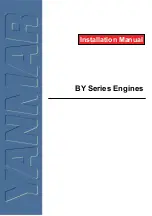
Turn on the kill switch and start the engine using an electric starter or by hand. If starting by hand, the engine
should start within about 5 or 6 flips.
Once the engine starts, maintain a fast idle for no less than 1 minute to allow the engine to warm up.
IMPORTANT
Make sure you never start the engine with the carburetor set any higher than the idle setting. Trying to start the
engine at a higher throttle setting will result in the engine backfiring. This can quickly lead to personal injury
and/or damage to the engine.
IMPORTANT
Your 46cc gasoline engine does not require it be run on a test stand and be broken in. It is flight ready. Be
aware though that when the engine is new, it won't produce the rpm and power that an engine that's been
running a while will. Expect rpm's to increase as you run the engine more and more. The engine will require
about 40 - 50 hours of run-time before it will produce its full power potential.
When you make adjustments to the carburetor, whether it's to the high or low speed needle valves, you must
shut off the engine and turn off the kill switch.
VERY IMPORTANT
Be careful never to lean the engine out too much. Remember that the lubricants for your engine are suspended
in the fuel. If you lean out the fuel mixture too much you will also be lowering the amount of lubricant entering
your engine. Less lubricant means more chance of your engine overheating and possible engine failure.
After following the starting procedure, allow the engine to idle for no less than 1 minute to allow it to adequately
warm up. After 1 minute, advance the throttle to full. Using a tachometer, adjust the high speed needle valve for
full power, then turn the high speed needle valve counterclockwise about 1/16 of a turn to richen the mixture
slightly. This is the setting at which you should fly the airplane.
Bring the throttle back down to idle and allow the engine to idle for 30 seconds. After 30 seconds, advance the
throttle to full. The engine should transition from idle to full power smoothly and quickly. If the engine quits
suddenly, the low speed needle valve is too lean. Shut off the engine and turn the low speed needle valve
counterclockwise 1/16 of a turn to richen the idle mixture. If the engine sputters and quits, the low speed needle
valve is too rich. Shut off the engine and turn the low speed needle valve 1/16 of a turn clockwise to lean the
mixture. Start the engine and check the transition again. If it's still not correct, repeat this procedure until you're
satisfied with the transition.
IMPORTANT
Once the carburetor settings are made, they will rarely need to be adjusted again, unless there are major
atmospheric changes or you change fuel or change the spark plug.
Avoid running the engine under dusty conditions or where there are loose rocks or sand.
Wipe the outside of the engine dry using a soft cloth. Use a fuel filter between the fuel tank and the
carburetor.
Periodically check to make sure all of the engine bolts are tight, including the engine mounting bolts.
Periodically check to make sure that the timing sensor, timing ring and ignition cables are not chaffed or
otherwise damaged.
Periodically check the condition and gap of the spark plug, especially when a noticeable drop in
performance is seen. If the spark plug electrode is damaged or worn, replace the spark plug.
Periodically check the condition of the spark plug boot and the grounding cable. The silicone boot should
be soft and pliable, and not show any signs of cracking or other damage.
Running The Engine
Maintenance

























